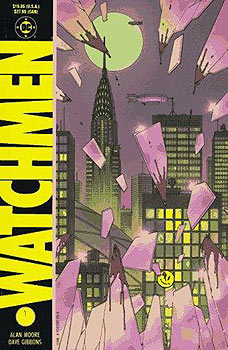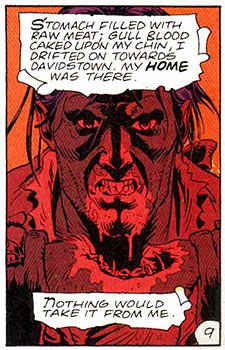We’re All Watching The Watchmen
Published on March 30th, 2009 in: Comics, Issues, Movie Reviews, Movies, Reviews |By Danny R. Phillips
Many times when a book is foolishly adapted for the big screen, the story becomes changed, warped, rearranged, and in the process, the fans of the original work leave the theater saying to themselves, “What was that?!?” Luckily, for director Zach Snyder, the film version of the so-called “greatest graphic novel of all time” is not one of those times.
You see, in a past life I was a comic book geek. For much of the 1980s and early 1990s (until I discovered women and the joys they could bestow upon me), I absorbed nearly every title presented to the world by the great Stan Lee and his Marvel Comics. I did not read much of DC’s catalog, thus helping to create the flimsy reason I had for not reading Watchmen until after I’d seen the film. I hang my head in shame.

The film, directed by the same guy who did 300, is a sprawling, world-hopping adventure spread over two hours and 43 minutes; had it followed the novel panel for panel as Snyder claimed he wanted to do, it would have clocked in around six or seven hours, which for me would have been fine. For my wife Mindi, not so much. Watchmen is dark and brooding, taking its cues from other films based on comics and the film noir of the 1940s; the alternate New York of 1985 is a world of grit, mega-corporations, masked heroes, and Richard M. Nixon as the sitting President. Yes, that Nixon.
In the world of Watchmen, masked heroes were outlawed in 1977 by The Keene Act, leaving them to retire to nursing homes, auto repair garages, insane asylums, and in the cases of The Comedian (Jeffrey Dean Morgan) and Jon “Dr. Manhattan” Osterman (Billy Crudup), they become weapons of varying severity for the US Government. Jon turns into an actual weapon after an accident in a government physics lab renders him a blue, glowing, always naked “God” who is able to transport himself, anything, or anyone wherever he wishes, to see into the future (and past), and overall, do whatever he wishes. The Comedian, on the other hand, is an amoral, fighting machine that does whatever his government asks without question or conscience; he was even in Dallas on November 22, 1963.
By 1985, the world is on the verge of Nuclear Armageddon as Russia invades Afghanistan and threatens the US; to make matters even worse, someone is killing off masks starting with The Comedian. The now-vigilante ex-hero Rorschach has a never wavering “moral compass” and is played with excellence by Jackie Earle Haley. If Heath Ledger received an Oscar for The Joker, Haley sure as hell better win for Rorschach.
As Rorschach and Nite Owl 2 race against an impending World War Three and try to avoid being killed by someone with a grudge against anyone in a funny suit, the pieces begin to fall into place and the true nature of the plan is revealed bit by bit until the final confrontation takes place in, of all places, a fortress in Antarctica. Sounds a bit like Superman’s digs at The Fortress of Solitude, huh?
And that’s the point. When Alan Moore and Dave Gibbons came up with the idea for Watchmen it was not an original idea; it was a combination of the ideals and talents of masked heroes that work together well. Watching the film, my wife would lean over to me and whisper, “This stuff seems familiar.” It does but it also doesn’t and that’s the point. We have all seen Watchmen even if we haven’t sat in a darkened theater and watched Rorschach throw hot grease in a inmate’s face and say: “You don’t get it! I’m not locked in here with you. . . you’re locked in here with me!” This brilliant line is the best one in the movie and sums up Rorschach’s existence. No compromise, no grey, just black and white, right is right, and stomping out wrong at all costs.
Alan Moore’s expert writing of the story is not that simple. There are grey areas; supposed good guys like The Comedian are some of the book’s biggest villains. After all, he shoots and kills a pregnant woman as Dr. Manhattan watches, doing nothing to stop it. Is it okay to blow up half of New York City to save the rest of the world from atomic war? Is it fine for Rorschach to kill criminals in the name of justice even though he himself becomes a criminal in the process? Where do we draw the line and what are the consequences for crossing it?

For time and spatial considerations there are some things from the novel that, unfortunately, do not make it to screen. The original masked crusaders, a group known as The Minutemen, get very little screen time and no lines. The murder of Hollis Mason (the original Nite Owl) by a street gang is never mentioned in the movie and the explanation of Walter “Rorschach” Kovacs’ blotch-covered mask is not broached. However, the biggest blatant omission is the story within a story that is Tales of The Black Freighter. The Black Freighter storyline in the book mirrors the events of the world and the action taken by Watchmen member Adrian “Ozymandias” Veidt. I will say no more about that for fear of divulging too much of the plot.
Yes, there are changes made between the novel and its silver screen counterpart. They are minor and will more then likely only be noticed by the fan boys, comic geeks, and people who read the novel after the fact (like me). In the grand scheme of it all, the changes are trivial and are worth it to bring what I now know is in fact, “The Greatest Graphic Novel of All Time” to the mass movie going audience. Is it the greatest comic-book-based film of all time? No, that distinction goes to Sin City, but Watchmen is a close second. Hopefully, it will bring people to the graphic novel and back to the written word as a whole.
In the film, there is graffiti spray painted on a wall that poses the question, “Who Watches The Watchmen?”
My answer is: Everyone. . .
Time limit is exhausted. Please reload the CAPTCHA.